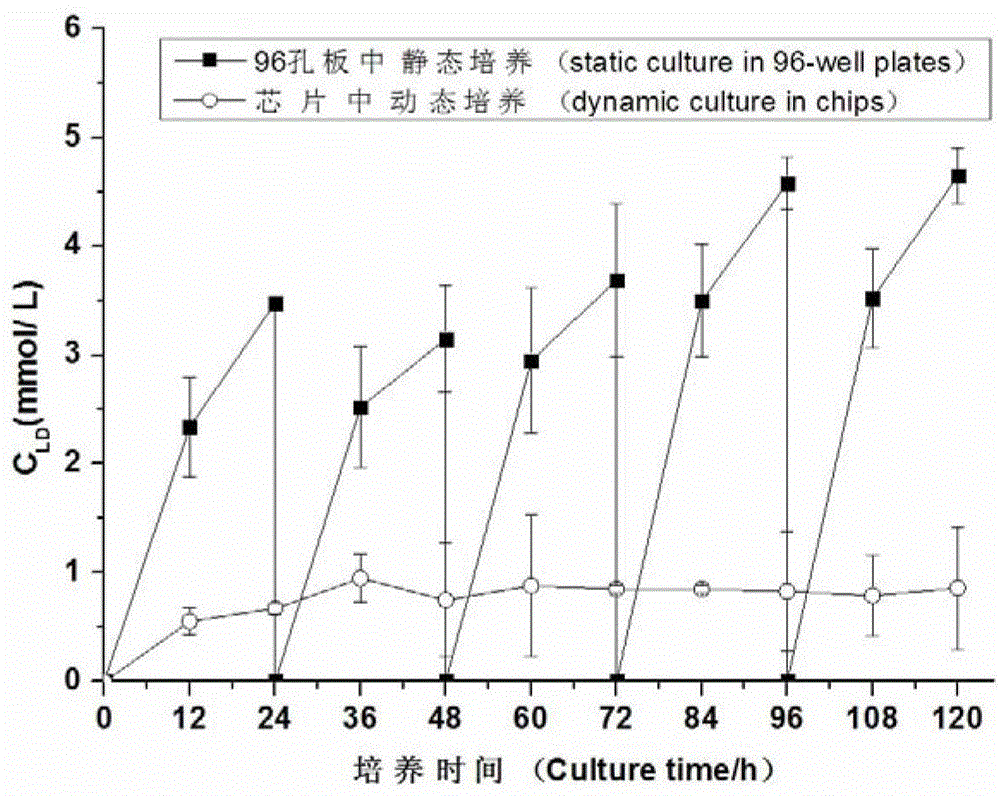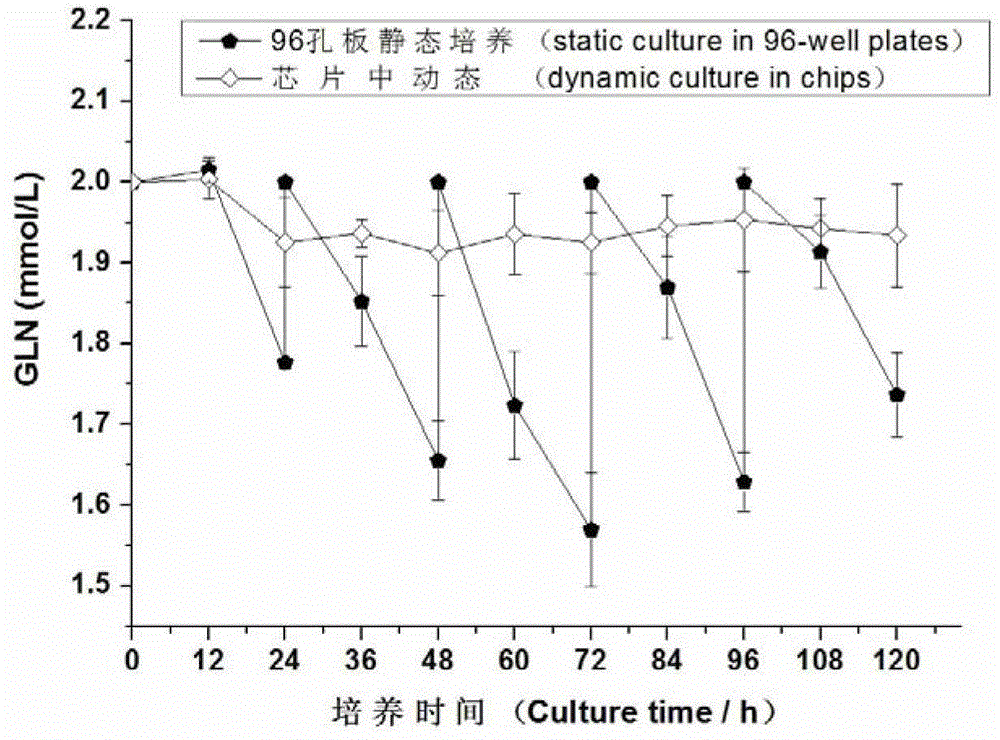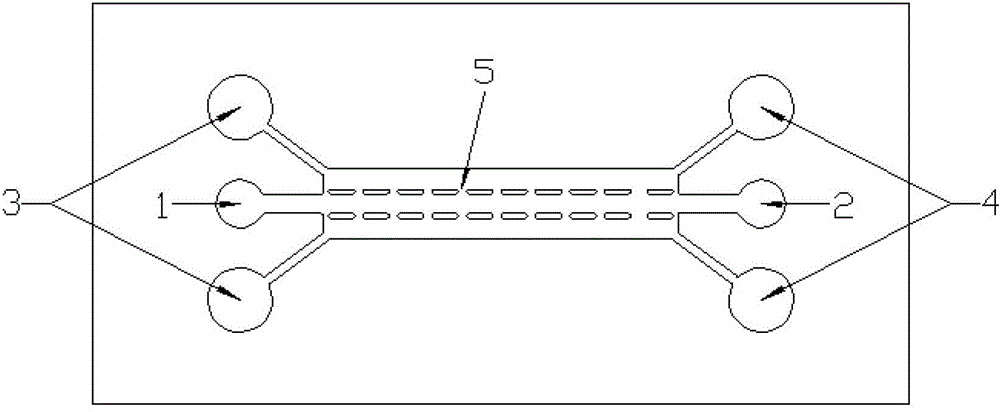Method for constructing three-dimensional neural stem cell model in two steps by adopting micro-fluidic technology
A microfluidic technology and neural stem cell technology, applied in the field of microfabrication technology and tissue engineering, can solve problems such as no standardized experimental methods, and achieve the effects of saving labor, good repeatability, and reducing cell culture costs
- Summary
- Abstract
- Description
- Claims
- Application Information
AI Technical Summary
Problems solved by technology
Method used
Image
Examples
Embodiment 1
[0036] Example 1 Design and fabrication of a microfluidic chip suitable for three-dimensional culture of neural stem cells
[0037] 1. Design of microfluidic chip
[0038] In order to provide a good microenvironment for the growth of NSCs-collagen complexes, this study designed a microfluidic chip suitable for the growth of NSCs-collagen complexes in vitro. The overall design of the chip is as follows: figure 1Shown: in the figure 1 is the left cell injection hole with a diameter of 2mm; 2 is the right cell injection hole with a diameter of 3mm; 3 is the waste liquid outlet with a diameter of 3mm; 4 is the cell culture chamber. The length of the cell culture chamber is 200 mm, the width is 1 mm, and the depth is 150 μm. Its internal structure is as figure 2 Shown: the side wall of the culture chamber is a palisade-like structure composed of several micropillars with a length of 100 μm and a width of 50 μm, and each microcolumn is spaced at a distance of 20 μm. There is a 4...
Embodiment 2
[0058] The screening of embodiment 2 NSCs in vitro serum-free expansion medium
[0059] This example aims to realize the massive expansion of NSCs in vitro under serum-free culture conditions, thereby providing sufficient cell numbers for the construction of a three-dimensional model of NSCs. The mixed culture solution of DMEM / F12 / RPMI1640 (1:1:1, V:V:V) was selected as the basic medium in the experiment, and four key components were selected from the commonly used additives: glucose (Glucose), glutamine ( Glutamine), lipids (Lipids), bovine serum albumin (BSA), 4 factors and three levels of orthogonal experiments were established to determine the optimal dosage of these 4 components in the expansion medium and their expansion of NSCs increase the effect.
[0060] Orthogonal experiments were divided into 9 groups, which were carried out on 24-well culture plates, and 3 wells were selected for parallel experiments in each group. The experimental cells were derived from the th...
Embodiment 3
[0068] Example 3 Construction of NSCs-collagen three-dimensional complex on microfluidic chip
[0069] In this example, the NSCs-collagen hydrogel mixture was first inoculated into the cell culture chamber of the microfluidic chip, and then the three-dimensional growth of NSCs in the collagen scaffold was realized by replacing the medium in a two-step method. The specific method is as follows:
[0070] 1. Preparation of single cell suspension
[0071] Transfer the third-generation NSCs "neurospheres" from the culture bottle to a 15ml centrifuge tube, centrifuge at 1000rpm for 5min, discard the supernatant, and collect the suspended neurospheres; add an equal volume of Accutase to the collection TM For enzymes, after shaking in a water bath at 37°C for 15 minutes, add 5ml of fresh medium, centrifuge at 1000rpm for 5min; discard the supernatant, resuspend the cells with 1ml of fresh medium, and place a polished Pasteur pipette against the end of the centrifuge tube At the bott...
PUM
| Property | Measurement | Unit |
|---|---|---|
| Length | aaaaa | aaaaa |
| Width | aaaaa | aaaaa |
| Depth | aaaaa | aaaaa |
Abstract
Description
Claims
Application Information
 Login to View More
Login to View More - Generate Ideas
- Intellectual Property
- Life Sciences
- Materials
- Tech Scout
- Unparalleled Data Quality
- Higher Quality Content
- 60% Fewer Hallucinations
Browse by: Latest US Patents, China's latest patents, Technical Efficacy Thesaurus, Application Domain, Technology Topic, Popular Technical Reports.
© 2025 PatSnap. All rights reserved.Legal|Privacy policy|Modern Slavery Act Transparency Statement|Sitemap|About US| Contact US: help@patsnap.com



